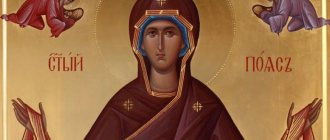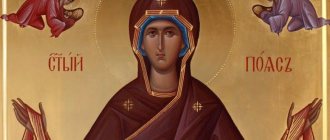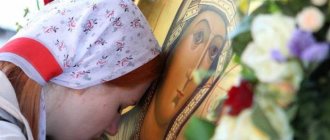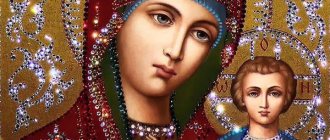Most Holy Theotokos, help us!
Every Christian trusts in the help of the Mother of God, turns to her in prayer, asks for the most dear, the most valuable. Who can measure the power of the love of the Blessed Virgin Mary for us, sinners and weaklings? This power surpasses human understanding - the Mother of God carried her Son to execution, to execution for our sins. We pray to the Lady, continuing to sin and crucify the Lord with our sins. And the Queen of Heaven never ceases to console us, encourage us, and heal us.
The Christian family has been given a great consolation - the belt of the Most Holy Theotokos. It was woven by the hands of the Most Pure One, entwined around the Holy Womb that bore God. This is material evidence of salvation left to help us.
Historical evidence
Two sources of the 10th century tell about the belt of the Blessed Virgin Mary and the Virgin Mary - the Minology of Basil II and the Synaxarion of the Byzantine Church.
According to the Minology, the robe and belt of the Mother of God were in Jerusalem. Then, under the emperor Arcadia, who ruled at the end of the 4th - beginning of the 5th century, they were transferred to Constantinople.
During the reign of Justin II (VI century), the belt was moved from the city of Zila to the Chalcopratian church in Constantinople. The shrine was placed in a golden ark, sealed with the royal seal of Emperor Arcadius.
Orthodox Life
The Holy Belt of the Mother of God, divided today into three parts, is the only relic or shrine that has been preserved from Her earthly life and is kept in the Sacred Great Monastery of Vatopedi.
Cancer with the Belt of the Blessed Virgin Mary. Vatopedi, Holy Mount Athos
According to legend, the Belt was made from camel hair by the Mother of God herself, and after Her Dormition, during Her Ascension into heaven, She gave it to the Apostle Thomas. “When You, most pure One, ascended to unsullied glory, with Your hand you bestowed Your most holy belt on the Apostle Thomas,” the Church sings on the day of the celebration of the placement of the Honorable Belt of the Mother of God.
Two poor pious women from Jerusalem took upon themselves the care of the Honorable Belt. Shortly before her Assumption, the Mother of God ordered the Evangelist John to divide her two robes between them. From generation to generation, the Belt was passed on for safekeeping to a pious maiden from this family.
During the reign of Emperor Arcadius, the son of Theodosius the Great, the Honest Belt was moved to the glorious capital of the Byzantine Empire, Constantinople. He was placed in a beautiful shrine, which was called the “holy shrine.” The situation occurred on August 31st. The sacred relic was supposed to protect the capital of the state and its inhabitants from enemy attacks, misfortunes and encroachments of evil spirits.
A few years later, Arkady’s daughter, Empress Pulcheria, erected the brilliant Chalcopratian Temple and placed the Honorable Belt in it.
In the next century, it is unknown exactly when and by whom, the Honest Belt was moved to the city of Zila, in Cappadocia, south of Amasea. It was again moved to Constantinople during the reign of Emperor Justinian I (527–565), during which the Hagia Sophia was built. His successor Justinian II and his wife Sophia restored the Chalcopratian temple and erected the small church of St. Reliquary. The Honorable Belt was kept on the Holy See.
The Holy Belt of the Virgin Mary performed many miracles in Constantinople. He healed Zoe Zautzi, the wife of Emperor Leo VI the Wise (886–912), who was tormented by an unclean spirit. When the patriarch placed the Holy Belt on her, she was immediately freed from her torment. As a sign of gratitude, she decorated the entire Belt with gold thread and in this form it has been preserved to this day in the Sacred Great Monastery of Vatopedi.
Patriarch Germanus I of Constantinople (715–730) said with lyricism that the Honest Belt forever preserves God’s fragrance of the healings he performed, giving joy to all who approach him with faith and reverence; and Joseph the Songsinger (approx. 816–866) sings of the shrine, since through the Grace of the Mother of God it sanctifies believers who come to reverently venerate her, protects them from harm and frees them from illness and sorrow.
Around 1150, the Honest Belt was located in the Great Chamber of Constantinople, in the Church of St. Michael. It was probably divided into parts that were moved to temples.
In the 12th century, particularly during the reign of Manuel I Komnenos (1143–1180), the Feast of the Holy Belt was officially established on August 31, whereas previously it was celebrated together with the Feast of the Robe of the Virgin Mary on July 2.
After the capture of Constantinople by the crusaders of the Fourth Crusade in 1204, some parts of the Belt were taken over by barbarian hordes, who carried them to the West. Fortunately, not all were lost. It is known for sure that part of the Honest Belt remained in Constantinople, and after its reconquest in 1261 by Michael VIII Palaiologos, it was kept in the Blachernae Church. The testimony of an anonymous Russian pilgrim in Constantinople, dated approximately 1424–1453, regarding the existence of the Holy Belt in Constantinople is the latest. It is unknown what happened subsequently, after the fall of Constantinople in 1453. The largest part of the Honest Belt that has survived to this day is kept in our Monastery. This part reached the monastery after many adventures.
Constantine the Great made a cross, which he took with him on military campaigns to protect himself and his troops. In the middle of the cross was a piece of the Honest Tree; it also had compartments in which the holy remains of the most significant martyrs and a piece of the Honest Belt were placed. All emperors took this cross with them on military campaigns. During one of the campaigns against the Bulgarians, Emperor Isaac II Angel (1185–1195) was defeated by the ruler Asan. Then one of the priests threw the royal cross into the river in order to prevent it from being desecrated by enemies. However, he was still found and handed over to the Bulgarian Tsar Asan.
The Bulgarians did not have very good relations with the Serbs, and they were constantly getting worse. Around 1330, in one of the battles, the Bulgarian army was completely defeated by the Serbian ruler, the Great Martyr Lazar (1389). So the royal cross passed into the hands of the Serbs. After forty years, Lazarus gave the Vatopedi monastery the royal cross along with a piece of the Honest Tree, a piece of the Honest Belt and other sacred remains. The inscription in Serbian on the reverse side of the Holy Cross reads: “Lazarus, in Christ God the prince of Serbia and the ruler of Greece, I bring as a gift a powerful weapon with the immaculate Belt of the Most Pure Virgin to the Vatopedi monastery of my kingdom.” Since then, it has been kept in the altar of the cathedral, that is, the central, temple of the Monastery.
One more legend that has been preserved in our Monastery cannot be ignored. According to him, the Honest Belt was presented as a gift by Emperor John VI Cantacuzene (1341–1354), who subsequently renounced the imperial title, became a monk with the name Joasaph and became a monk at the Vatopedi Monastery.
During the years of Turkish rule, the brothers of the monastery traveled, making religious processions with the Holy Belt throughout Crete, Macedonia, Thrace, Constantinople and Asia Minor, in order to sanctify and support enslaved Hellenism and protect it from all kinds of infectious diseases.
An excerpt from the collection “Miracles of the Holy Belt. Sacred Great Monastery of Vatopedi"
Miraculous gift of the Mother of God
Apostle Thomas, by God's providence, was not at the funeral of the Mother of God. He was very sad that he did not say goodbye to the Lady. As a consolation, the Most Holy Theotokos appeared to him and lowered her belt from heaven. This plot is found in Orthodox icons. In Greece, on Mount Athos, in the Dionysiates monastery there is a fresco from the 16th century. On it, Thomas holds out the Lady’s belt to the rest of the disciples, as if letting them admire it.
Vatopedi: belts of the Virgin Mary
Share
Honest Belt of the Blessed Virgin Mary Photo: www.pemptousia.ru
Athos monasteries not only have an ancient history, but are also guardians of unique shrines. One of them is the belt of the Blessed Virgin Mary, which the Virgin Mary wore during her lifetime. After the miraculous ascension of the Mother of God into Heaven, Her belt remained in Her empty tomb and became a real shrine for ancient Christians.
At first, the belt of the Virgin Mary was in Palestine, but in the 5th century it was moved to the capital of the Eastern Roman Empire - Constantinople. There he was in the imperial Blachernae church.
In the middle of the 12th century, the belt of the Virgin Mary was transported to Athos - to the Vatopedi monastery. This ancient monastery enjoyed the patronage of the Greek and Serbian nobility. Therefore, Vatopedi has always been a prosperous and influential monastery. And it remains so today. But thanks to its shrines.
Every day, many pilgrims come to Vatopedi to venerate its relics, in particular, the belt of the Virgin Mary. Since ancient times, Orthodox Christians have believed that by touching the belt they can receive healing from various diseases. The first documented case of such healing occurred in the 10th century in Constantinople, when Empress Zoe was cured of a serious illness thanks to a belt. Since then, such miracles have happened constantly. In Vatopedi you will find huge volumes describing cases of healing.
As you've probably heard, only men can get to Mount Athos. This is not discrimination against women, but a long-standing tradition that protects the monks of Athos from temptation. However, the inhabitants of Vatopedi tried to ensure that women also had access to the belt of the Mother of God. After all, it is believed that the belt helps overcome infertility.
At certain intervals, the shrine is taken to the mainland. There, everyone can bow to her - men, women, and children. Several years ago, a unique event occurred when the belt of the Mother of God was taken outside Greece for the first time. At the request of the hierarchy of the Russian Church, the Vatopedi monks brought the shrine to Moscow and other cities of Russia.
For several centuries now, Vatopedi monks have been making small belts that are blessed on the belt of the Virgin Mary. The monastery sends these belts free of charge by mail to everyone. Getting a belt is easy. It’s enough just to write to the monastery. In your response letter you will receive a small belt, which, through the prayers of the Mother of God and the brethren of Vatopedi, will help you in your needs.
The fate of the shrine in the 21st century
After the conquest of Constantinople by the Turks, the belt was taken out and divided into parts. In the 21st century, parts of the shrine are located in different places - in Cyprus, Georgia and France, Belgium, the Netherlands and Italy. The most famous one is kept in the Vatopedi monastery on Mount Athos.
You can venerate the shrine in the Church of Elijah the Prophet in Obydensky Lane in Moscow, in the Trinity-Sergius Lavra and the Cathedral of the Kazan Icon of the Mother of God in St. Petersburg.
Chomsky relic
Apostle Thomas preached the Gospel in India. From there he was raptured to the Dormition of the Ever-Virgin Mary, and there he returned after Her Ascension. According to legend, it was in India that the belt of the Blessed Virgin Mary was kept for about four centuries. In 476, the shrine was hidden in the altar of the ancient Syrian church of Um al-Zunnar.
For many centuries the belt was considered lost. In 1953, an ancient scroll in Aramaic was discovered in the city of Mardin, located in Turkey. The document stated that the shrine was hidden in the altar of the Church of the Belt of the Virgin Mary in the city of Homs. To find it, many people and hierarchs gathered - Orthodox and other Christian communities.
A slab with an inscription in Aramaic was found under the altar: “This temple was founded in 59 AD.” Under the slab, a marble cube was discovered, and inside the cube was a silver ark, in which lay a folded woven belt made of camel hair, embroidered with gold threads, 60 centimeters long.
Scientists examined the find and confirmed that it is about a thousand years old. The relic became an object of worship, miracles were so frequent that an exhibition of crutches and prostheses that were no longer needed was assembled at the temple.
In 1982, a small part of the shrine was separated and donated to Christians in the Indian province of Malankari, where miraculous healings still occur to this day.
Since its discovery, the belt was kept in Homs, in a silver vessel in the shape of a flower with openwork petals, standing on a stand. During the war with ISIS, the belt was taken to a quieter area of the country. On August 15, 2014, the relic was returned to Homs in triumph.
The Church of the Belt of the Blessed Virgin Mary is not in Eucharistic communion with the Orthodox Church.
Vatopedi - custodian of the greatest Orthodox shrine
Vatoped
Part of the relic was kept by the Byzantine rulers. They went into battle with her. According to legend, a piece of the belt was kept in the cross, and the last of the Byzantine emperors who owned the shrine was Isaac II Angel), from whom the belt passed to the Bulgarian Tsar Ivan Asen, who defeated Isaac in battle. Then the relic went to the Serbian princes. The last owner, Prince Lazar, in the 14th century donated the belt to the Athos monastery of Vatopedi, where it is kept to this day.
Pilgrims testify to the subtle aroma that emanates from the shrine. The entire Orthodox world knows about miracles that constantly occur by the grace of God.
You need to touch the belt of the Virgin Mary not with your lips, but with your hand
On November 19, a great Orthodox shrine - the belt of the Blessed Virgin Mary - was brought to the capital for the first time. It will be exhibited in the Cathedral of Christ the Savior from November 19 to 27.
Almost 40 thousand believers gathered at the main church of the country, not only from Moscow and the Moscow region, but also from Minsk, Brest, Voronezh, Stavropol, Belgorod and other cities of Russia and neighboring countries (read further).
A special flight from Kaliningrad has already delivered one of the most revered Christian shrines - the belt of the Blessed Virgin Mary - to Moscow's Vnukovo-3 airport. Moscow will be the last Russian city where the relic can be seen.
The plane landed in the capital at about 15.00 Moscow time, the board was met on the tarmac by representatives of the clergy and Moscow Mayor Sergei Sobyanin (hereinafter).
The belt is a Christian relic; it belonged to the Virgin Mary, mother of Jesus Christ. Tradition tells that before her Dormition, the Mother of God gave her belt and robe to two Jerusalem widows, who kept them and passed them on from generation to generation. It is believed that the shrine works miracles, heals infertility, female diseases, and bestows family happiness. In ancient times, they believed that it brings good luck in war. Several centuries ago, the belt was divided into parts and presented to the temples of Italy, Cyprus and Georgia. They are bringing us a fragment from the Vatopedi Monastery of Athos, where it was kept for almost seven hundred years.
— There will be a huge number of people in Moscow who want to approach the relic. Therefore, we decided to change the tradition of approaching it,” said the sacristan of the Cathedral of Christ the Savior, Archpriest Mikhail Ryazantsev. - Believers will pass by the ark and touch it with their hands, not with their lips. This is not in the tradition of our church. But this is being done so that as many people as possible can join in. Since the line will go quickly, I advise you to write notes in advance about the health of your loved ones and submit them to the church servants who receive the requests to read them at the prayer service.
Believers are ready to stand in line for days to venerate the relic.
Photo: TASS
How to kiss
— We must remember: it is not so much touching it that is important, but prayer for yourself and for your loved ones, the feeling of the real presence of the Queen of Heaven Herself. It is they who will bring spiritual consolation and healing to those who are worthy of it,” explained the archpriest. “Therefore, you need to approach with reverence, patiently.” Without succumbing to various temptations, doing unceasing prayer.
Which prayer to read:
To whom shall I cry, Lady? To whom shall I resort in my sorrow, if not to You, Queen of Heaven? Who will accept my cry and my sighing, if not You, Most Immaculate, the hope of Christians and refuge for us sinners? Who will protect You more in adversity? Hear my groaning and incline Your ear to me, the Lady Mother of my God, and do not despise me who requires Your help, and do not reject me, a sinner.
Enlighten and teach me, Queen of Heaven; do not depart from me, Thy servant, Lady, for my grumbling, but be my Mother and Intercessor. I entrust myself to Your merciful protection: lead me, a sinner, to a quiet and serene life, so that I may weep for my sins. To whom shall I resort when I am guilty, if not to You, the hope and refuge of sinners, inspired by the hope of Your ineffable mercy and Your bounty?
O Lady, Queen of Heaven! You are my hope and refuge, protection and intercession and help. My Queen, Most Offering and Speedy Intercessor, cover my sins with Your intercession, protect me from enemies visible and invisible; soften the hearts of evil people who rebel against me. O Mother of the Lord my Creator!
You are the root of virginity and the unfading color of purity. O Mother of God! Give me help to those who are weak with carnal passions and those who are sick at heart, for one thing is Yours and with You the intercession of Your Son and our God; and through Your wonderful intercession may I be delivered from all misfortune and adversity, O Most Immaculate and Glorious Mother of God, Mary. The same with hope I say and cry out: Rejoice, full of grace; Rejoice, Delighted One; Rejoice, Most Blessed One: the Lord is with You!
My Blessing Queen, my hope, Mother of God, Friend of the orphans and the strange, the Representative of the sorrowing, the Joy of the offended, the Patroness! See my misfortune, see my sorrow, help me as I am weak, feed me as I am strange. Weigh my offense, resolve it as if you will: for I have no other help except You, no other Representative, no good Comforter, only You, O Mother of God, for you will preserve me and cover me forever and ever. Amen.
O Most Holy Virgin, Mother of the Lord Most High, Intercessor and Protector of all who resort to You! Look down from Thy holy height upon me, a sinner (name), who falls before Thy most pure image; hear my warm prayer and offer it before Your Beloved Son, our Lord Jesus Christ; beg Him to illuminate my gloomy soul with the light of His Divine grace, to deliver me from all need, sorrow and illness, to grant me a quiet and peaceful life, physical and mental health, to pacify my suffering heart and heal its wounds, to guide me for good deeds, may my mind be cleansed from vain thoughts, and having taught me to fulfill His commandments, may He deliver me from eternal torment and may He not deprive me of His Heavenly Kingdom.
O Most Holy Theotokos! You, “Joy of all who mourn,” hear me, the sorrowful one; You, called “Quenching of Sorrow”, quench my sorrow; You, “Burning Kupino”, save the world and all of us from the harmful fiery arrows of the enemy; You, “Seeker of the Lost,” do not allow me to perish in the abyss of my sins. According to Bose, all my hope and hope is in Tyabo. Be a temporary Intercessor for me in life, and an Intercessor for eternal life before Your Beloved Son, our Lord Jesus Christ. Teach me to serve this with faith and love, and to reverently honor You, Most Holy Mother of God, Most Blessed Mary, until the end of my days. Amen.
Virgin Lady Theotokos, who bore in her womb the Savior Christ and our God, I place all my hope in You, I trust in You, the highest of all Heavenly powers. You, Most Pure One, protect me with Your Divine grace. Direct my life and guide me in accordance with the holy will of Your Son and our God. Grant me remission of sins, be my refuge, protection, protection and guide, leading me into eternal life.
In the terrible hour of death, do not leave me, my Lady, but hasten to help me and deliver me from the bitter torment of demons. For in Your will you also have power; Do this as truly the Mother of God and sovereign over all. Accept the worthy gifts brought to You alone by us, Your unworthy servants, most merciful, all-holy Lady Mother of God, chosen from all generations, who turned out to be superior to every creature in heaven and earth. Since through You we came to know the Son of God, through You the Lord of hosts became with us, and we were made worthy of His holy Body and Blood, then blessed are You throughout all generations, most blessed of God, most holy of the Cherubim and most glorious of the Seraphim; and now, praying, O All-Holy Mother of God, do not cease to beg for us, Thy unworthy servants, to free us from every wiles of the evil one and from every extreme, and to keep us unwounded in every poisonous attack.
Even to the end, through Your prayers, keep us uncondemned, so that, saved by Your intercession and Your help, we will always send glory, praise, thanksgiving and worship to the one God in the Trinity and the Creator of all. Good and most blessed Lady, Mother of the good, all-good and all-good God, look upon the prayer of Thy unworthy and indecent servant with Thy merciful eye, and act with me according to the great mercy of Thy ineffable compassion and do not look at my sins, both in word and in deed, and with every feeling done, voluntarily and involuntarily, with knowledge and in ignorance, and renew me all, making me the temple of the all-holy, life-giving and sovereign Spirit, Who is the power of the Most High, and overshadowed Your all-pure womb, and dwelt in it.
For You are the helper of the weary, the representative of the needy, the savior of the distressed, the haven of the troubled, the protector and intercessor of those in extremity. Grant to Your servant contrition, silence of thoughts, constancy of thought, a chaste mind, sobriety of soul, a humble way of thinking, a holy and sober mood of spirit, a prudent and well-ordered disposition, which serves as a sign of spiritual composure, as well as piety and peace, which our Lord gave to His disciples.
May my prayer come to Thy holy temple and to the dwelling place of Thy glory; May my eyes be drained of sources of tears, and may You wash me with my own tears, whiten me with streams of my tears, cleansing me from the filth of passions.
Blot out the handwriting of my sins, dispel the clouds of my sorrow, darkness and confusion of thoughts, remove from me the storm and desire of passions, keep me in serenity and silence, expand my heart with spiritual expansion, rejoice and rejoice me with unspeakable joy, unceasing joy, so that in the right paths of the commandments I followed Thy Son faithfully and with a blameless conscience I lived an untroubled life.
Give me, praying before You, pure prayer, so that with an undisturbed mind, unwandering meditation and with an insatiable soul, I may constantly study the words of the Divine Scriptures day and night, sing in confession, and in the joy of my heart offer prayer to the glory, honor and magnification of the only begotten Son. Yours and our Lord Jesus Christ. To Him belongs all glory, honor and worship, now, and always, and unto the ages of ages! Amen.
The Ark with the Belt of the Blessed Virgin Mary was brought to Moscow by the monks of the Vatopedi Greek monastery on Athos.
Photo: TASS
BY THE WAY
Athonite monks will stand at the ark and distribute ribbons consecrated on the Belt of the Most Holy Theotokos - small belts made of linen. They will go to everyone who has already touched the shrine.
If someone doesn’t have time to come, it doesn’t matter.
“For two years now, a piece of the Robe of the Most Holy Theotokos has been in the Cathedral of Christ the Savior. In terms of significance and healing power, it is not inferior to the Belt. “Everyone who visits the temple can venerate it completely freely on any day,” reassured the sacristan Mikhail Ryazantsev. “I can tell those who are sick that the most important thing for them is communion of the Holy Mysteries of Christ. To do this, you don’t need to travel huge distances and stand in queues for hours; you just need to contact a priest from the nearest church.
BY THE WAY
Believers will be guarded by one and a half thousand police officers
In St. Petersburg with a population of five million, about a million (!) people came to touch the Belt. In Moscow with a population of 12 million, it is expected that there will be at least 3.5 million applicants.
“We will withdraw more than one and a half thousand police officers per day,” said Vyacheslav Kozlov, head of the public order department of the capital’s main headquarters of the Ministry of Internal Affairs. “But if it happens like in St. Petersburg, when the line reached two kilometers, we will have to use more serious forces.”
If there are too many pilgrims, the traffic police will close traffic between the Bolshoi Kamenny and Crimean bridges.
Will change its routes and transport. From November 19 to 27, trolleybuses No. 16 from the Karacharovsky overpass will only run to Yauz Gate Square.
On these days, the Kropotkinskaya Metro stop for trolleybuses No. 2 and No. 44 is cancelled. The stop “Museum of Fine Arts - Metro Kropotkinskaya” for trolleybuses No. 1, No. 33 and bus No. 6 is also cancelled.
In addition, as Komsomolskaya Pravda was informed by Mosgortrans, the Prechistenskaya Embankment stop for trolleybus route No. 33 has been canceled. There is a line of tow trucks at the temple - it will be possible to get there only by metro.
At the Cathedral of Christ the Savior, lists are being drawn up for passage to the belt of the Virgin Mary . In the temple itself, these actions are called amateur performances - entry will be free
There is still a day before the shrine arrives at the temple, but a crowd is already gathering at the gates. At noon on Friday, about three hundred people stood outside the massive doors. A lady in a mourning headscarf holds notebook leaves. It's the lady's turn. This is a record of those wishing to worship: the person who comes up says his name and the number of parishioners who will come with him to worship the shrine. We are on list 307.
Photo: Marina VOLOSEVICH
There is also a second stage. There are about a hundred people in it. And one of these hundred constantly shouts to the lady in black: “Don’t do nonsense! There will be a live queue"
We call the press service of the Patriarchate. They are surprised there.
“This is the initiative of the parishioners,” says Father Alexander Volkov, deputy head of the press service of the Patriarch of Moscow and All Rus'. — The shrine will arrive at the temple on November 19 at 16:00, it will be available for worship from 19:00 on Saturday, the first parishioners will be allowed into the temple on a first-come, first-served basis. As much as the temple can accommodate. Then there will be an evening service. Access will be until 8:30 am on Sunday. Then there will be a short break. And from approximately 10 am on November 20 until November 27, access to the shrine will be around the clock. Freely available (read more).
Photo: Marina VOLOSEVICH
Position of the Belt of the Blessed Virgin Mary
Icon of the Position of the Belt of the Blessed Virgin Mary
The wife of the Constantinople emperor Leo VI the Wise, who reigned in 886-912, was tormented by demonic possession. The husband and relatives of the sick woman constantly prayed for the healing of Empress Zoe. After this, the woman had a revelation from above: she would recover if the belt of the Most Holy Theotokos was placed on her.
At that time, Euthymius II was the patriarch. The emperor asked to open the ark with the belt. The Patriarch removed the seal, opened the ark and took out the belt of the Queen of Heaven. With reverence, all those present kissed the perfectly preserved shrine, and then the patriarch spread it over the aching one. Immediately she felt completely healthy.
With joy and gratitude, all those involved praised the Lord and His Most Pure Mother. The healed empress personally embroidered the shrine with gold threads. The Patriarch composed a song of praise for the worship of the shrine. The belt was returned to the ark, sealed with the royal seal and a holiday was established in honor of the Most Glorious Mother of God in memory of the miracle that occurred from Her belt by the grace of our Lord Jesus Christ.
The solemnity of the Position of the Belt of the Blessed Virgin Mary is celebrated on September 13 according to the new style.
LiveInternetLiveInternet
History of the Belt of the Virgin Mary
According to the legend that has reached us, the Mother of God wove a belt from camel hair herself and wore it until her dormition (death). This shrine and particles of the robe are the only things of the Virgin Mary that have survived to this day. There are two versions of how the Virgin Mary disposed of her belt. According to one, the Mother of God, after her death, appeared to the Apostle Thomas and gave him the belt as a consolation, because... He was the only one among the apostles who did not say goodbye to her, but appeared only on the third day after the burial and grieved greatly about it. Another version is taken from the Minology of Basil II and states that the belt was given by the Mother of God shortly before her death to two widows living in Jerusalem, and then the relic was passed on by the heirs from generation to generation. (approx. Minology of Basil II - an illustrated Byzantine manuscript in the genre of hagiographic literature, compiled in 979-989) In the 4th century, the emperor of the Eastern Roman Empire Arcadius delivered the belt of the Virgin to Constantinople to the Chalcopratian church. The relic was placed in a golden ark, sealed with the royal seal. In 458, Emperor Leo I moved it to the Blachernae Church. Until the end of the 12th century, the belt remained in Constantinople. In the 10th century, the belt of the Virgin Mary was divided into parts. The emperors of Byzantium took one of the parts of the shrine with them on military campaigns as a talisman. In 1185, during the struggle of Bulgaria for its independence from the Byzantine Empire, this part of the belt of the Virgin Mary was captured and ended up in Bulgaria, from where it later came to Serbia. In the 14th century, the Serbian prince Lazar I donated the belt along with a piece of the true Cross of the Lord to the Vatopedi monastery on Mount Athos, where it is kept to this day in the sanctuary of the main monastery cathedral. The following claim to own the remaining parts of the belt of the Virgin Mary: - Blachernae Church in Zugdidi (Georgia); — Cathedral of Prato (Italy); — Trier Monastery (Germany); - Church “Umm Zunnar” (“Temple of the Belt of the Virgin Mary”) in Homs (Syria). The celebration of the belt, called the “Position of the Honorable Belt of the Blessed Virgin Mary,” takes place on August 31 (old style), September 13 (new style). Miracles of the Belt of the Virgin Mary
The wife of Leo VI the Wise (866-912), Zoe, was overwhelmed by an unclean spirit. The emperor asked the patriarch to open the ark with the holy relic. The belt turned out to be completely untouched by time. After it was applied to the patient, she completely got rid of her illness. As a token of gratitude to the Mother of God for the miracle, the empress embroidered the belt with gold thread, after which it was again enclosed in the ark and sealed. In 1827, the founder of the Hilandar monastery, Father Savva, writes: “In Enos, the pestilence of the plague stopped with the grace of the Holy Belt of the Mother of God,” and then, after the holy Belt was transported to Didimotikhon, the following entry appears: “Here, as in Enos, the pestilence ceased by the grace of the holy Belt.” At the end of the 19th century, the Turkish Sultan Abdul-Aziz turned to the monks of Vatopedi with a request for a belt in connection with the cholera epidemic that was raging in Constantinople. As soon as the ship with the shrine on board approached the pier of Constantinople, the epidemic raging in the city stopped, and the already sick people began to recover. Abdul Aziz was so amazed by this event that he ordered the belt to be brought to his palace so that he could honor it. In 1894, residents of the city of Madita (Asia Minor) were plagued by locusts that destroyed standing crops. Desperate people asked the fathers of the Vatopedi monastery to provide them with the belt of the Virgin Mary to fight this evil. As soon as the ship with the Belt approached the harbor, a cloud of locusts rising from the fields darkened the sky and then, to the amazement of those present, rushed into the sea. The miraculous belt of the Virgin Mary still performs many miracles. He is especially revered for the help he provides to women suffering from infertility. The Vatopedi Monastery contains many letters in which women who have found the joy of motherhood enclose photographs of their babies born through this relic. “Agiazonites” (that is, “holy belts” - the nickname given to the Vatopedi monks) help infertile women without violating the rules of their male monastery (after all, visiting the monastery for women is strictly prohibited). On the ark, where the belt of the Virgin Mary is kept, they consecrate the ribbons and distribute them to the husbands of infertile couples. These improvised prayer belts are tied around the woman’s waist and worn until childbirth. How to properly wear the belt of the Most Holy Theotokos Here are excerpts from the brochure-memo issued with the belt: “...Believers gird themselves with this belt for a while, living in repentance, confession, prayer and communion of the Holy Mysteries. Spouses do the same, adding to this fasting and conjugal abstinence, if possible and by mutual agreement...” So nothing complicated - tie a belt, believe, live righteously and may you be rewarded according to your Faith.
Prayer to the belt of the Virgin Mary
Reverence
Pilgrims are constantly heading to Vatopedi, letters are arriving. They go to pieces of the shrine stored in different countries.
Service at the Vatopedi Monastery
People have great faith in the gracious power of the belt of the Blessed Virgin Mary. And indeed, miracles occur continuously - in spite of all diagnoses, infertile people conceive, the lame and crippled are healed, the mentally ill gain health, drunkards and drug addicts leave their addictions. There are no number of miracles that occurred during a difficult pregnancy or difficult childbirth. As a sign of gratitude, warmed by the miraculous help of the Queen of Heaven, Christians send letters and photographs of children as evidence of the miracle.
Currently, one of the great shrines of the Orthodox world has arrived in Russia - the Belt of the Blessed Virgin Mary.
Holy Belt of the Virgin Mary and Vatopedi Monastery
The Virgin Mary gives the belt to the Apostle Thomas
The belt of the Blessed Virgin Mary, which today is divided into three parts, is the only surviving relic of her earthly life. According to Tradition, the belt was woven from camel hair by the Virgin herself, and after the Dormition during the Ascension, she gave it to the Apostle Thomas.
In the first centuries of the Christian era it was located in Jerusalem. It is known that in the 4th century it was kept in the Cappadocian city of Zela, and in the same century Emperor Theodosius the Great again brought it to Jerusalem. From there his son Arkady delivered the Belt to Constantinople.
At first, the shrine was placed in the Chalkopration temple, from where in 458 Emperor Leo I moved it to the Blachernae Church. During the reign of Leo VI the Wise (886-912), the Belt was brought to the imperial palace, and with its help, the basileus' wife Zoe was healed.
She was overwhelmed by an unclean spirit, and the emperor prayed to God for healing. She had a vision that she would be cured of her weakness if the Belt of the Virgin Mary was placed on her. Then the emperor asked the patriarch to open the shrine.
The Patriarch removed the seal and opened the shrine in which the relic was kept. The belt of the Mother of God turned out to be intact and undamaged by time. The Patriarch applied the Belt to the sick empress, and she immediately got rid of her illness.
Emmanuel Tzanes. Miracle of the Holy Belt.
As a sign of gratitude to the Mother of God, the Empress embroidered the entire Belt with gold thread. This is how it acquired the appearance it has today. With hymns of thanksgiving, he was again placed in the shrine, and the shrine was sealed.
In the 12th century, during the reign of Manuel I Komnenos (1143-1180), the holiday of the Holy Belt was officially established, held on August 31. Before that, he was honored on July 1, in a joint celebration with the Honest Robes of the Virgin Mary.
The belt remained in Constantinople until the end of the 12th century. But among the consequences of the defeat of Isaac Angel from the Bulgarian king Asan in 1185 was that the Belt was stolen and taken to Bulgaria. Later he fell to the Serbs.
Prince Lazar I gave the Belt along with a piece of the true Cross as a gift to the Vatopedi Monastery. Since then, it has been kept in the sanctuary located in the katholikon, the main monastery cathedral.
During the reign of the Turks, the brethren of the monastery took the Belt with them when they went to Crete, Macedonia, Thrace, Constantinople and Asia Minor. They did this in order to spread the grace of the shrine, raise the spirit of the enslaved Greeks and save them from the epidemics that occurred.
The miracles revealed through the holy Belt in all centuries are innumerable. Here are just a few examples.
One day, the inhabitants of Enos asked that the holy Belt be delivered for them, and the priest sheltered the monks accompanying the relic in his home. His wife secretly cut off a piece of the Belt. When the fathers gathered back and boarded the ship, it did not move, although the sea was quiet. The priest's wife, seeing this strange incident, realized that she had acted unrighteously, and returned part of the Belt to the monks. The ship immediately sailed.
The flap remained separated. Subsequently, a similar incident occurred.
During the Greek War of Independence, the Holy Belt was brought to Crete at the request of its inhabitants, who were suffering from a plague. But when the monks were about to return to their monastery, the Turks arrested them and took them away for execution. Meanwhile, the British consul Domenicos Sanantonio bought the holy Belt and it was taken to Santorini, where the diplomat's new residence was located.
Immediately this news spread throughout the island. The local bishop notified the Vatopedi monastery, and its abbot Dionysius went to Santorini. The consul asked for 15,000 piastres as ransom for the Belt. The islanders showed unanimity and were able to collect this amount. So the holy Belt was returned, and Abbot Dionysius took it to Vatopedi.
The consul's wife did the same as the priest's wife at Enos. She secretly cut off a small piece of the Holy Belt from her husband before it was returned to Abbot Dionysius. After a short time, her husband died suddenly, and her mother and sister became seriously ill. In 1839, she sent a letter to the monastery asking that the monastery send messengers who would receive the cut piece from her.
In 1864, the Holy Belt was brought to Constantinople when cholera was raging there. As soon as the ship carrying the Belt approached the harbor, the destruction ceased, and none of those struck by it died.
This strange, miraculous event aroused the Sultan's curiosity. He ordered that the Belt be brought to his palace so that he could honor it.
During the stay of the Holy Belt in Constantinople, a Greek from the Galata quarter asked that it be brought to his home. His son was seriously ill, but when the holy Belt was delivered, he had already died. However, the monks did not lose hope. They asked to be shown the remains, and as soon as the Belt was placed on them, the young man rose from the dead.
In 1894, the inhabitants of the city of Madita in Asia Minor wanted the holy Belt to be brought there because locusts were devastating their crops and spoiling their fruit trees. When the ship carrying the Belt approached the harbor, the sky was darkened by clouds of locusts, which then rushed into the sea, and the ship could not cast anchor. The Miditites on the shore, having seen the miracle, began to continuously sing the hymn “Kyrie eleison” (Greek Κύριε ελέησον - “Lord, have mercy!”).
Until our time, many miracles have been performed through the holy Belt. Thus, women suffering from infertility receive a braid from the reliquary where the Belt is kept. If they have faith, they find it in the womb.
Miracles that occurred through the Holy Belt of the Blessed Virgin Mary
Ending the pestilence
August 22, 1827 Father Savva writes:
“In Enos, the pestilence of the plague was stopped by the beneficial action of the Holy Belt of the Virgin Mary.”
From Enos the holy Belt was transported to Didymotikhon. In another letter, dated September 12, the same father reports:
“Here, as in Enos, the pestilence was stopped by the grace of the holy Belt.”
Getting Rid of a Locust Infestation
Father Cosmas Chrysoulas, in a report for the monastery, writes:
“In 1915, we asked that the Holy Belt from the Vatopedi monastery be brought to our village of Neochori, as well as to Kallipoleos. The reason for this was a locust invasion. When the Belt was delivered, flocks of birds appeared in the sky and began to eat the locusts. Thus we were saved from this disaster."
Holy Belt in Ithaca
On the island of Ithaca, a relic - a light brown belt embroidered with gold thread - was kept by Mrs. Euphemia Sofianou from Vafu. This holy relic of St. Joachim gave it to his maternal grandmother Maria Molfesi-Sofianu.
The belt was placed near the home iconostasis, and was given to girls who tied it around their heads or bellies during the wedding sacrament as a kind of sign of virginity. This was considered a great blessing. He was then returned to the Sofianou family.
The last time it was given to a refugee family was in 1935. This family had a custom of rebaptizing sick children with this belt. Unfortunately, the relic was lost during a devastating earthquake in 1953.
Rescue from drought
In 1957, several residents of Thasos arrived at the monastery. They asked for the holy Belt to be delivered to their island. The fact is that for several years there was no rain there, and drought threatened depopulation. The fathers agreed and decided to go to Thasos a few days later.
According to monastic tradition, when the holy Belt leaves the walls of the monastery, the fathers accompany the holy Belt on a solemn procession to the small port. They hold banners and censers, and the ringing of church bells can be heard. On the way to the sea they sing a prayer canon to the Mother of God.
So it was that day, and the fathers boarded a small ship sailing to Thasos, which was 2-3 hours away. The weather was clear and there were no signs that rain was coming.
When they reached the port of Thasos, there was already a downpour there, so heavy that they could not leave the ship. And they returned to the monastery, giving praise to the Most Holy Theotokos, who intervened and saved the pious islanders, seeing the goodness of their intentions and heeding their calls.
Translation by Sergei Akishin specially for Orthodoxy and Peace.
Prayers
Troparion of the Position of the Honorable Belt of the Blessed Virgin Mary
voice 8
Ever-Virgin Mother of God, covering of men,/ the robe and girdle of Thy most pure body,/ Thou hast granted sovereign taxation to Thy city,/ by Thy seedless Nativity, incorruptible,/ for Thy nature is renewed and time is renewed./ In the same way, we pray to Thee to grant peace to Thy city/ and to the souls to our great mercy.
Kontakion of the Venerable Belt of the Blessed Virgin Mary
voice 2
Your God-pleasing womb, Mother of God,/ Your generous, honorable belt/ the power of Your city is unconquerable/ and the treasure of good things is endless,/ the only one who gave birth to the Ever-Virgin.
Kontakion of the Venerable Belt of the Blessed Virgin Mary
voice 4
The honorable belt of Thy position/ is celebrated today by Thy, Thrilling Temple/ and diligently calls upon Thee:/ Rejoice, O Virgin,/ praise to Christians.
We thank
the Vatopedi Monastery on Holy Mount Athos for the photographs provided. Currently, the belt is in the Novodevichy Convent in St. Petersburg and will remain there until October 24.
How to pray
To become a communicant of a miracle, it is not enough to simply tie a belt consecrated on the belt of the Most Holy Theotokos. It is best to contact your confessor, or, at the very least, any priest who will advise a prayer rule for the period of wearing the shrine. It would be right for the duration of the prayerful feat to undergo a feasible fast - to give up entertainment, marital intimacy, and possibly savory food.
The consecrated belt can be placed in the holy corner.
Before kissing the shrine, you should pray - say the Archangel greeting “Virgin Mother of God, rejoice,” or sing the troparion and kontakion of the Position of the Belt of the Most Holy Theotokos. Position of the Holy Belt of the Blessed Virgin Mary










